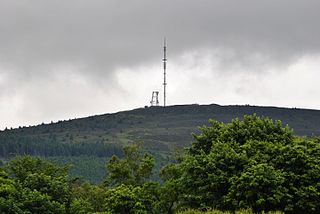Television in the Republic of Ireland is available through a variety of platforms. The digital terrestrial television service is known as Saorview and is the primary source of broadcast television since analogue transmissions ended on 24 October 2012. Digital satellite and digital cable are also widely used.

BBC Northern Ireland is a division of the BBC and the main public broadcaster in Northern Ireland.

TG4 is an Irish free-to-air television channel for Irish-language speakers. It launched on 31 October 1996. TG4 is also available to watch online live and to view previously broadcast programmes from around the world through the TG4 Player.
Digital terrestrial television is a technology for broadcast television in which land-based (terrestrial) television stations broadcast television content by radio waves to televisions in consumers' residences in a digital format. DTTV is a major technological advance over the previous analog television, and has largely replaced analog which had been in common use since the middle of the 20th century. Test broadcasts began in 1998 with the changeover to DTTV beginning in 2006 and is now complete in many countries. The advantages of digital terrestrial television are similar to those obtained by digitising platforms such as cable TV, satellite, and telecommunications: more efficient use of limited radio spectrum bandwidth, provision of more television channels than analog, better quality images, and potentially lower operating costs for broadcasters.
Digital terrestrial television in the United Kingdom encompasses over 100 television, radio and interactive services broadcast via the United Kingdom's terrestrial television network and receivable with a standard television set. The majority of digital terrestrial television (DTT) services, including the five former analogue channels, are broadcast free-to-air, and a further selection of encrypted pay TV services are also available.

The digital switchover is the name given to the process by which analogue terrestrial television in the United Kingdom was replaced with digital terrestrial television. It is sometimes referred to as the "analogue switch off".
The deployment of digital terrestrial television in Ireland has taken some time, with the first small tests being carried out in 1998. 2002 saw the cancellation and non-award of the DTT commercial licence and transmission network sale. In August 2006, a major regional DTT trial began in conjunction with major television channels in Ireland including Raidió Teilifís Éireann, TV3, TG4 and the now-defunct Channel 6. By 2008 the Broadcasting Commission of Ireland announced that three groups had come together with proposals to manage commercial DTT in Ireland, which was awarded to Boxer DTT Ltd.

Clermont Carn, variously spelt as "Clermont Cairn", "Clairmont Carn/Cairn" and Carnán Mhaighréid Náir in Irish is a 510m high peak in the Cooley Mountains in County Louth, Ireland, which is also home to a main 2RN transmission site.
There are four major forms of digital television (DTV) broadcast in the United Kingdom: a direct-to-home satellite service from the Astra 28.2°E satellites provided by Sky UK, a cable television service provided by Virgin Media ; a free-to-air satellite service called Freesat; and a free-to-air digital terrestrial service called Freeview. In addition, an IPTV system known as BT Vision is provided by BT. Individual access methods vary throughout the country. 77% of the United Kingdom has access to HDTV via terrestrial digital television. Satellite is the only source of HDTV broadcast available for the remaining 23%.
The Broadcasting (Amendment) Act 2007 is an Act of the Oireachtas. It deals with Irish Analogue broadcasting systems and the amendment of legislation on Digital Terrestrial Television dating back to 2001. This act amends previous acts, in particular the Broadcasting Act 2001. It was enacted in April 2007.
The media in Northern Ireland are closely linked to those in the rest of the United Kingdom, and also overlap with print, television, and radio in the Republic of Ireland.
Television in Northern Ireland is available using, digital terrestrial, digital satellite and cable.
Boxer DTT Limited was a company that had been awarded the contract to operate a mainly pay-TV digital terrestrial television service in Republic of Ireland.
The Broadcasting Act 2009 is an Act of the Oireachtas of Ireland. It was signed into law on 12 July 2009, although the provisions relating to the establishment of the new Broadcasting Authority of Ireland did not come into force until a Statutory Instrument was made giving them effect on 30 September 2009.
OneVision was a consortium that has been offered a licence by the Broadcasting Authority of Ireland to run the pay television services on the DTT platform in the Republic of Ireland.

Raidió Teilifís Éireann is a semi-state company and the national public service media of Ireland. It both produces programmes and broadcasts them on television, radio and the Internet. The radio service began on 1 January 1926, while regular television broadcasts began on 31 December 1961, making it one of the oldest continuously operating public service broadcasters in the world. RTÉ also publishes a weekly lifestyle magazine called the RTÉ Guide.
Saorview is the national digital terrestrial television (DTT) service in Ireland. It is owned by RTÉ and operated by 2RN.
Easy TV was a consortium that have been offered a licence by the Broadcasting Authority of Ireland (BAI) to run the pay television services on the DTT platform in the Republic of Ireland. It was last one standing and least preferred in the 2008 contest results.
Saorsat is a free-to-air satellite service in Ireland. The service launched on 3 May 2012.
The following is a list of events relating to television in Ireland from 2010.











